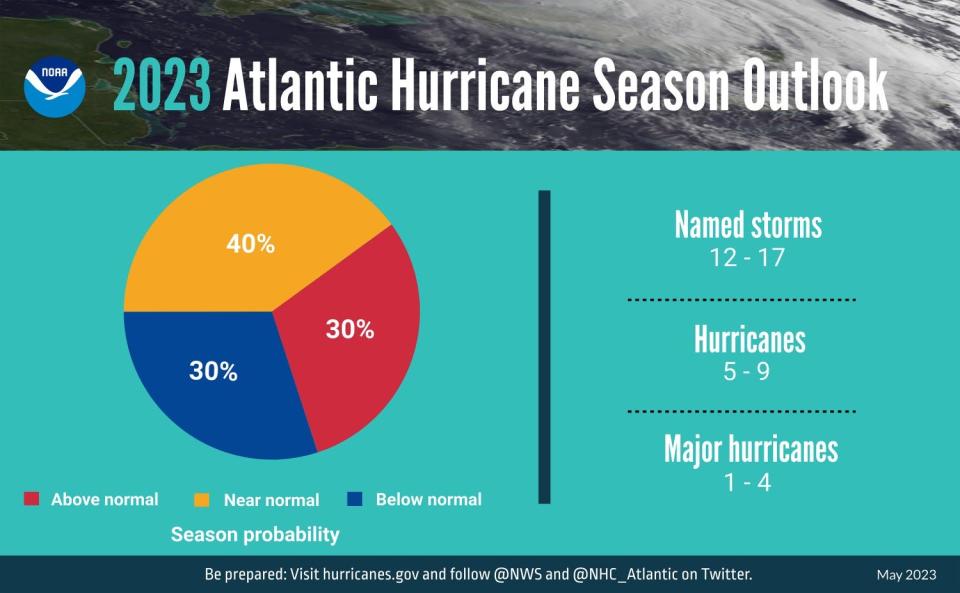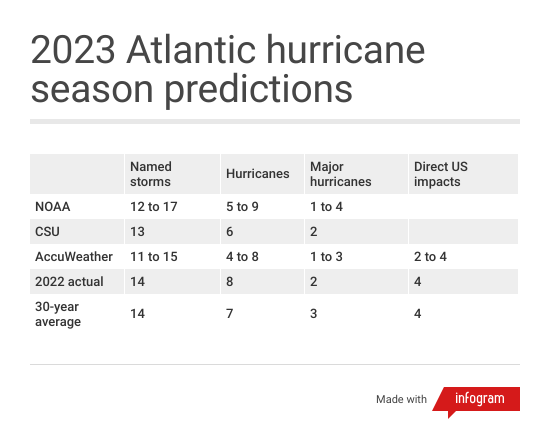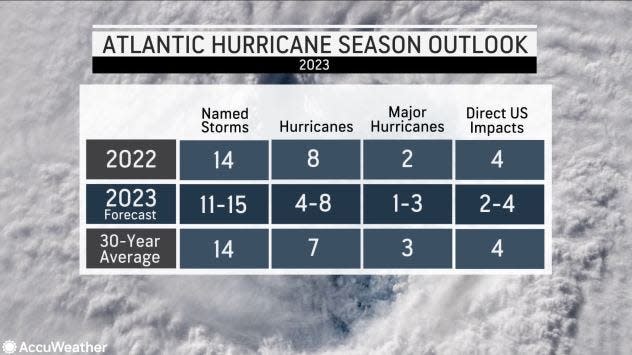NOAA predicts 'near normal' hurricane season with 12-17 named storms and 5-9 hurricanes
The National Oceanic and Atmospheric Administration forecasts 12 to 17 named storms will develop during the 2023 Atlantic hurricane season, making it a "near-normal" season.
The prediction from federal forecasters was released this morning.
El Niño and warmer-than-average ocean temperatures were factors affecting the agency's seasonal outlook.
The Atlantic basin covers the tropical Atlantic, Gulf of Mexico and Caribbean Sea.
Tropics watch: NHC tracking system off Southeast, 3 tropical waves
CSU hurricane forecast: CSU predicting 13 named storms, 2 major hurricanes this season
AccuWeather hurricane forecast: AccuWeather issues 2023 hurricane season forecast, predicting 11-15 named storms
Overall, NOAA predicts there will be a 40% chance of a near-normal season, a 30% chance of an above-normal season and a 30% chance of a below-normal season.
NOAA predicts 12 to 17 named storms in 2023

Federal forecasters predicted a near-normal season, with 12 to 17 named storms. Out of those, five to nine are predicted to become hurricanes.
One to four of the hurricanes could become a major storm. A major hurricane is one where maximum sustained winds hit 111 mph or higher and is rated as Category 3, 4 or 5 on the Saffir-Simpson Scale. An average season typically spawns seven hurricanes.
Impact of El Niño: El Niño could return in 2023; what that means for the world's weather
A tropical storm contains wind speeds of 39 mph or higher and becomes a hurricane when winds reach 74 mph.
The upcoming Atlantic hurricane season, which begins June 1, is expected to be less active than recent years due to competing factors — some that suppress storm development and some that fuel it — driving this year's overall forecast for a near-normal season.
The development of El Niño this summer is expected to help offset favorable tropical storm conditions in the Atlantic, including warmer-than-normal water temperatures.
How do 2023 hurricane predictions compare?

NOAA's predictions are very close to those released earlier by Colorado State University and AccuWeather, although the upper range is slightly higher.
AccuWeather forecasters predict 11 to 15 named storms

Current projections indicate the 2023 season will be near the historical average with 11 to 15 named storms, according to AccuWeather.
Four to eight of those named storms are expected to reach hurricane strength, with one to three of those hurricanes achieving major hurricane status. A major hurricane is one that has maximum sustained winds of 111 mph or higher.
“We are also projecting two to four direct impacts on the United States, including Puerto Rico and the Virgin Islands,” said senior meteorologist and hurricane expert Dan Kottlowski.
Colorado State University forecasters predict 13 named storms this season

The early prediction for the season calls for 13 named storms, slightly below the average of 14.4 storms, according to CSU forecasters.
Six hurricanes are forecast, with two becoming major hurricanes. Those figures fall below the average of 7.2 hurricanes and 3.2 major hurricanes.
National Hurricane changes for 2023
Extended forecast: One of the biggest changes is extending the long-range forecast from the previous forecast of two and five days to two and seven days. The actual visual forecast "cone" provided by the NHC will not be extended yet.
Invest numbers: Invests, systems forecasters are watching as potential areas of development, have always been assigned a sequence of numbers and letters. That designation will now be part of the tropical outlooks.
Storm surge graphic: While storm-surge graphics have been shown experimentally since 2020 on NHC's website, 2023 marks the first time they becomes fully operational. The graphic depicts peak storm surge forecast inundation values from the tropical cyclone advisory when storm-surge watches or warnings are in effect.
Watches and warnings removed from forecast advisory: The warnings will still be part of the public advisory, but to avoid duplication and chances for errors, they'll be removed from the forecast advisory this year.
Forecast cone: The size of the tropical cyclone track forecast error cone for the Atlantic basin will be about the same as compared to 2022.
Livestream broadcasts: The National Hurricane Center will experimentally provide simultaneous livestream broadcasts via its YouTube, Facebook and Twitter accounts when there is a system in the tropics that may pose a threat to land.
Storm surge flooding map for Puerto Rico, Virgin Islands: The potential storm surge flooding map issued by the National Hurricane Center that is currently produced for the U.S. Gulf and East Coasts will be expanded to include Puerto Rico and the U.S. Virgin Islands.
Pronunciation guide: NHC is providing a site that describes exactly how to pronounce a storm.
Hurricane season dates for the Atlantic basin
The Atlantic hurricane season runs from June 1 through Nov. 30. The Pacific hurricane season runs from May 15 through Nov. 30.
The Atlantic basin includes the Atlantic Ocean, Caribbean Sea and the Gulf of Mexico.
What can Florida expect during the 2023 hurricane season?
AccuWeather forecasters said Florida will once again be at a higher risk than other parts of the country.
“Based on climatology and an evolving El Niño pattern during August through October, the highest chance for direct and significant impacts will be from the Florida Panhandle around the entire state of Florida to the Carolina coast,” Kottlowski said.
Atlantic hurricane names for 2023
Here are the names for storms during the 2023 Atlantic hurricane season:
Is your name on the list? Here are the 2023 Atlantic hurricane season names.
Arlene
Bret
Cindy
Don
Emily
Franklin
Gert
Harold
Idalia
Jose
Katia
Lee
Margot
Nigel
Ophelia
Philippe
Rina
Sean
Tammy
Vince
Whitney
Want to make sure you're pronouncing them correctly?
What are hurricane classifications?
Hurricanes receive a classification on the Saffir-Simpson Hurricane Wind Scale. The ranking — between one and five — depends on maximum sustained winds, with one being a minimal hurricane and five being the worst. The scale does not take into account other hazards, such as storm surge, rainfall flooding and tornadoes.
Category 1: Winds of 74-95 mph.
Very dangerous winds will produce some damage. Well-constructed frame homes could have damage to roof, shingles, vinyl siding and gutters. Large branches of trees will snap and shallowly rooted trees may be toppled. Extensive damage to power lines and poles likely will result in power outages that could last a few to several days.
Category 2: Winds of 96-110 mph.
Extremely dangerous winds will cause extensive damage. Well-constructed frame homes could sustain major roof and siding damage. Many shallowly rooted trees will be snapped or uprooted and block numerous roads. Near-total power loss is expected with outages that could last from several days to weeks.
Category 3: Winds of 111-129 mph. Hurricanes with maximum sustained winds of 111 mph and higher are classified as major hurricanes.
Devastating damage will occur. Well-built framed homes may incur major damage or removal of roof decking and gable ends. Many trees will be snapped or uprooted, blocking numerous roads. Electricity and water will be unavailable for several days to weeks after the storm passes.
Category 4: Winds of 130-156 mph.
Catastrophic damage will occur. Well-built framed homes can sustain severe damage with loss of most of the roof structure and/or some exterior walls. Most trees will be snapped or uprooted and power poles downed. Fallen trees and power poles will isolate residential areas. Power outages will last weeks to possibly months. Most of the area will be uninhabitable for weeks or months.
Category 5: Winds of 157 mph and higher.
Catastrophic damage will occur. A high percentage of framed homes will be destroyed, with total roof failure and wall collapse. Fallen trees and power poles will isolate residential areas. Power outages will last for weeks to possibly months. Most of the area will be uninhabitable for weeks or months.
What is the cone of uncertainty?
The "cone of uncertainty" issued by the National Hurricane Center tracks the most likely center of the storm. It is made up of a series of connecting circles, one for each time frame in the forecast. Previously, that forecast extended five days. Starting this year, the forecast will extend out to seven days.
Together, the circles become a cone, narrow at first and wider as the forecast period continues with more uncertainty.
2023 NHC changes: National Hurricane Center changes in 2023 include forecast cone extending out 7 days
The cone of uncertainty: Many people misunderstand this famous hurricane forecast graphic. It can be a deadly mistake.
The circles do not take into consideration the size of a storm, just the probable location of the eye.
Confusion often results by people taking the cone literally.
The entire seven-day track stays within the cone about two-thirds of the time, said James Franklin, one of the Hurricane Center's retired hurricane specialists. There is always a chance the center of the storm could be outside the circles or even outside the cone, depending on several factors, including how fast it is moving.
This article originally appeared on Palm Beach Post: NOAA predicts 12 to 17 storms, up to 9 hurricanes this season

